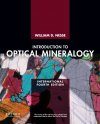Textbook
By: William D Nesse(Author)
361 pages, 1 fold-out chart with 1 colour & 1 b/w illustration; b/w photos, b/w illustrations, tables
![Introduction to Optical Mineralogy (International Edition) Introduction to Optical Mineralogy (International Edition)]()
Click to have a closer look
About this book
Contents
Customer reviews
Biography
Related titles
About this book
The fourth edition of Introduction to Optical Mineralogy has been thoroughly revised and updated to increase reading comprehension and improve the clarity of its illustrations. Author William D. Nesse continues his detailed discussions of the petrographic microscope, the nature and properties of light, and the behavior of light in isotropic and anisotropic minerals, with detailed coverage of uniaxial and biaxial optics. Ideal for advanced undergraduate and graduate courses in optical mineralogy, this accessible text is also an essential resource for petrology and petrography courses.
Contents
Chapter 1
Light
The Nature of Light
Electromagnetic Radiation
Phase
The Perception of Color
Interaction of Light and Matter
Transmitted Light
Velocity
Index of Refraction
Reflection
Critical Angle and Total Internal Reflection
Optical Class
Optical Indicatrix
Dispersion
Light Absorption and Color
Polarized Light
Polarization by Double Refraction
Polarization by Reflection
Polarization by Scattering
Chapter 2
The Petrographic Microscope
Direction Conventions
Samples
Illuminator
Substage Assembly
Microscope Stage
Objective Lenses
Epi-Illuminator
Upper Polarizer
Bertrand Lens
Ocular
Focusing Mechanism
Accessories
Additional Equipment
General Care of the Microscope
Adjustment of the Microscope
Adjusting the Oculars
Focusing
Adjusting the Illuminator
Centering the Objectives
Adjusting the Substage
Alignment of Polarizers
General Considerations
Chapter 3
Refractometry
Relief
Becke Line Method
Dispersion Effects
Oblique Illumination Method
Practical Considerations
Accuracy of the Immersion Method
Determining Indices of Refraction in Thin Section
Chapter 4
Optics of Isotropic Materials
Isotropic Indicatrix
Distinguishing Between Isotropic and Anisotropic Minerals
Identification of Isotropic Minerals
Grain Mount
Thin Section
Chapter 5
Optics of Anisotropic Minerals: Introduction
Interference Phenomena
Monochromatic Illumination
Retardation
Birefringence
Interference of the Two Rays
Polychromatic Illumination
Orders of Interference Colors
Anomalous Interference Colors
Determining Thickness of a Sample
Thin Section
Grain Mount
Determining Birefringence from the Color Chart
Thin Section
Grain Mount
Recognizing the Different Orders of Interference Colors
Extinction
Categories of Extinction
Use of the Accessory Plates
Sign of Elongation
Relief
Pleochroism
Chapter 6
Uniaxial Optics
Optic Sign
Crystallographic Considerations
Uniaxial Indicatrix
Use of the Indicatrix
Birefringence and Interference Colors
Extinction
Tetragonal Minerals
Hexagonal Minerals
Rhombohedral Cleavage
Prismatic and Pinacoidal Cleavage
Pleochroism
Interference Figure
Optic Axis Interference Figure
Formation of Isochromes
Formation of Isogyres
Determining Optic Sign
Off -Center Optic Axis Figure
Flash Figure
Selecting Grains to Give Interference Figures
Optic Axis Figure
Flash Figure
Determining Indices of Refraction
Grain Mount
Determining nω
Determining nε
Thin Section
Spindle Stage
Chapter 7
Biaxial Optics
Biaxial Indicatrix
Mathematical Relationships
Use of the Indicatrix
Normal Incidence Parallel to an Indicatrix Axis
Normal Incidence Parallel to an Optic Axis
Normal Incidence In a Random Direction
Inclined Incidence
Crystallographic Orientation of Indicatrix Axes
Orthorhombic Minterals
Monoclininc Minerals
Triclinic Minerals
Biaxial Interference Figure
Acute Bisectrix Figure
Formation of Isochromes
Vibration Directions and Formation of Isogyres
Centered Optic Axis Figure
Obtuse Bisectrix Figure
Optic Normal Figure
Off -Center Figures
Selecting Grains to Produce Interference Figures
Determining Optic Sign
Acute Bisectrix Figure
Obtuse Bisectrix Figure
Optic Axis Figure
Flash Figures
Determining 2V
2V Versus 2E
Mallard's Method
Tobi's Method
Kamb's Method
Wright Method
Pleochroism
Extinction
Orthorhombic Minerals
Monoclinic Minerals
Triclinic Minerals
Sign of Elongation
Indices of Refraction
Grain Mount
Spindle Stage
Dispersion in Biaxial Minerals
Orthorhombic Minerals
Monoclinic Minerals
Triclinic Minerals
Chapter 8
Reflected Light Optics
Physical Properties Observed with Polished Sections
Crystal Form and Habit
Hardness
Observation in Plane Polarized Light
Reflectance
Bireflectance
Measurement of Reflectance and Bireflectance
Color and Pleochroism
Isotropic Minerals
Anisotropic Minerals
Observations with Crossed Polarizers
Polarization Colors
Isotropic Minerals
Anisotropic Minerals
Internal Reflection
Observations Related to Conoscopic Illumination
Practical Considerations
Chapter 9
Identification of Minerals
Descriptive Features
Cleavage
Twinning
Alteration
Association
Tactics for Mineral Identification
Thin Section Identification
Grain Mount Identification
Polished Section Identification
Use of the Identification Tables
Nonminerals
Problems in Paradise
Inconsistencies in Crystallographic Settings
Poor Data
Chapter 10
Framework Silicates
Silica Group
Quartz
Chalcedony
Tridymite
Cristobalite
Opal
Volcanic Glass
Feldspars
Plagioclase
Thin Section
Grain Mount
Alkali Feldspars
Sanidine
Orthoclase
Microcline
Adularia
Anorthoclase
Feldspathoids
Nepheline
Sodalite Group
Leucite
Cancrinite-Vishnevite
Zeolites
Analcime (Analcite)
Natrolite
Thomsonite
Stilbite
Chabazite
Heulandite
Laumontite
Other Framework Silicates
Scapolite
Chapter 11
Sheet Silicates
TO Layer Silicates
Kaolinite
Serpentine
TOT Layer Silicates
Pyrophyllite
Talc
TOT + Interlayer Cation Layer Silicates
Muscovite
Biotite
Lepidolite
Glauconite
Margarite
Clintonite
TOT + O Layer Silicates
Chlorite
Clay Minerals
Other Sheet Silicates
Stilpnomelane
Prehnite
Apophyllite
Chapter 12
Chain Silicates
Pyroxenes
Enstatite-Ferrosilite (Orthopyroxene)
Pigeonite
Calcic Clinopyroxene (Augite)
Aegirine, Aegirine-Augite
Omphacite
Jadeite
Spodumene
Amphiboles
Anthophyllite
Gedrite
Cummingtonite-Grunerite
Tremolite-Actinolite-Ferro-actinolite
Hornblende
"Oxyhornblende"
Kaersutite
Richterite
Arfvedsonite and Eckermannite
Glaucophane-Riebeckite Series
Pyroxenoids
Wollastonite
Rhodonite
Pectolite
Other Chain Silicates
Sapphirine
Chapter 13
Disilicates and Ring Silicates
Disilicates
Lawsonite
Pumpellyite
Melilite
Vesuvianite (Idocrase)
Epidote Group
Zoisite
Clinozoisite-Epidote
Piemontite
Allanite
Ring Silicates
Tourmaline
Axinite
Beryl
Cordierite
Chapter 14
Orthosilicates
Olivine
Monticellite
Humite Group
Garnet Group
Andalusite
Sillimanite
Kyanite
Staurolite
Chloritoid
Titanite (Sphene)
Topaz
Zircon
Dumortierite
Chapter 15
Carbonates, Borates, Sulfates, and Phosphates
Carbonates
Calcite
Magnesite
Siderite
Rhodochrosite
Dolomite-Ankerite
Aragonite
Strontianite
Witherite
Malachite
Azurite
Borates
Borax
Colemanite
Sulfates
Barite
Celestine (Celestite)
Gypsum
Anhydrite
Alunite
Phosphates
Apatite
Monazite
Xenotime
Chapter 16
Native Elements, Sulfides, Halides, Oxides, and Hydroxides
Native Elements
Sulfur
Graphite
Gold
Silver
Copper
Sulfides and Related Minerals
Pyrite
Marcasite
Sphalerite
Galena
Pyrrhotite
Chalcopyrite
Halides
Halite
Sylvite
Fluorite
Oxides
Periclase
Cuprite
Rutile
Anatase
Cassiterite
Corundum
Hematite
Ilmenite
Perovskite
The Spinel Group
Spinel Series
Magnetite
Chromite
Chrysoberyl
Hydroxides
Brucite
Gibbsite
Diaspore
Böhmite (Boehmite)
Goethite
Lepidocrocite
Limonite
Appendix A: Sample Preparation
Grain Mount
Thin Section
Spindle Stage
Polished Section
Appendix B: Identification Tables
Appendix C: Mineral Associations
Mineral Index
Subject Index
Customer Reviews
Biography
William D. Nesse is Professor Emeritus in the Department of Earth Sciences at the University of Northern Colorado.
Textbook
By: William D Nesse(Author)
361 pages, 1 fold-out chart with 1 colour & 1 b/w illustration; b/w photos, b/w illustrations, tables














![Minerales de las Islas Canarias [Minerals of the Canary Islands]](http://mediacdn.nhbs.com/jackets/jackets_resizer_medium/22/225122.jpg?height=150&width=104)



















